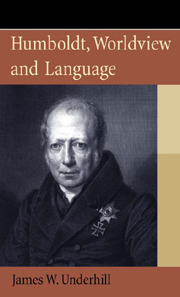Book contents
3 - What Do We See in the Term Worldview?
from Part I - Language and World
Published online by Cambridge University Press: 12 September 2012
Summary
Worldview is a term with a colourful past. For many French scholars, it has an American origin and is associated primarily with what has come to be known as the Whorf-Sapir hypothesis, according to which ‘a language's difference results in a different intellectual and affective structuring’ for the mind of the speaker of a language community (Dubois et al. 1994: 511, mT). The term has been traced back from its use by Benjamin Lee Whorf (1897–1941) and his teacher, Edward Sapir (1884–1939), to the work of the great anthropologist, Franz Boas (1858–1942), who is responsible for having stressed the importance of language for culture in his ethnological exploration of Amerindian cultures. Indeed, it was the confrontation with the very different cultures and languages of North America that forced linguists (used to working within the frameworks of Indo-European languages) to re-evaluate some of their fundamental premises about language. In this sense, the origin of the term is, indirectly, more Amerindian than American. It is also worth noting that both Boas and Sapir were of Jewish- German origin, Boas having emigrated to the United States in his late twenties and Sapir having been brought there as a child of five years old. Both no doubt drew on their knowledge of Hebrew and German as alternative worldviews to the outlook American English offered as the natural ordering of the world.
- Type
- Chapter
- Information
- Humboldt Worldview and Language , pp. 14 - 19Publisher: Edinburgh University PressPrint publication year: 2009



